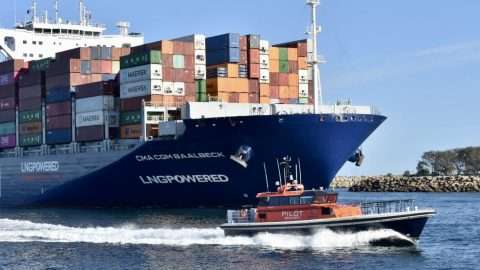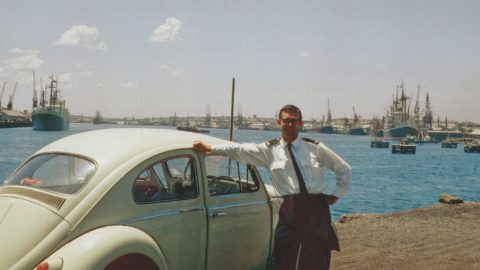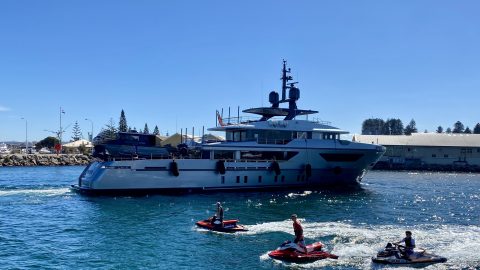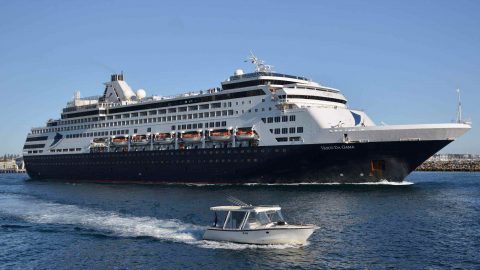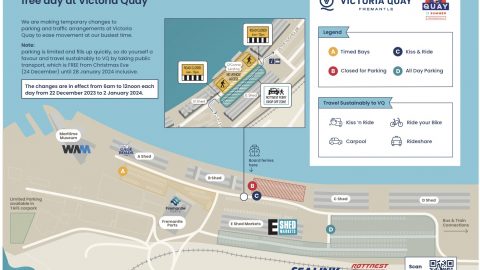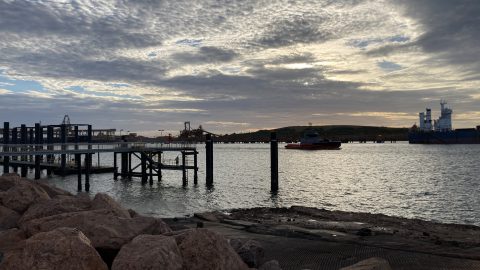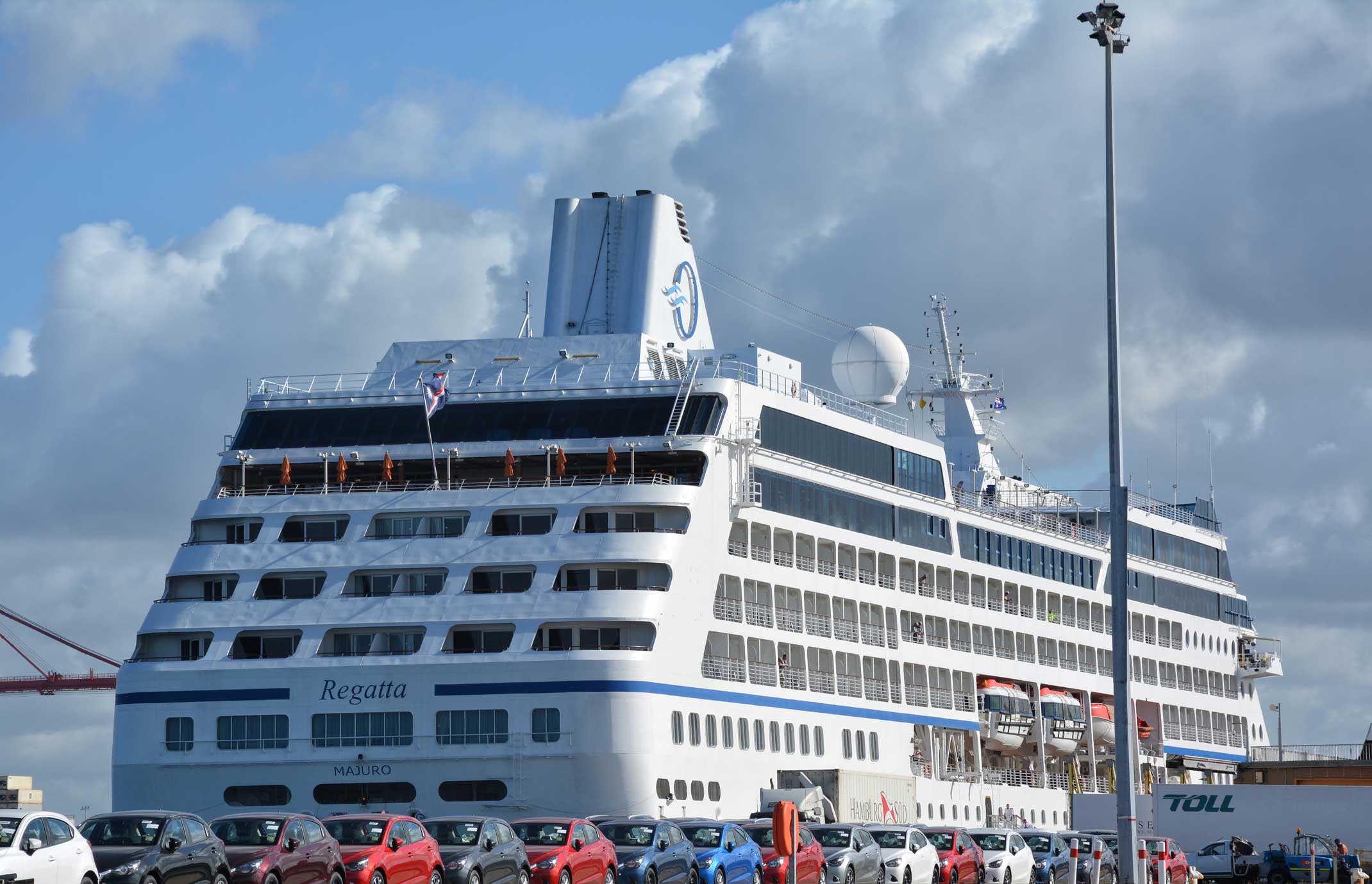Foxy Lady II was a Jeanneau, French design – Sun Shine 38.
Here she is, the star of this story, at anchor off West Island, Cocos (Keeling) Islands, March 1988.
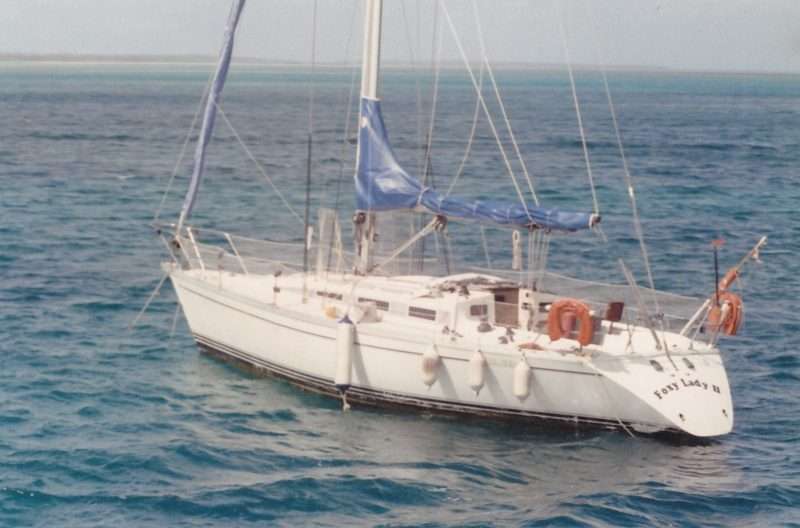
Foxy Lady II had a LOA or length overall of 12 m (38’), WLL or water line length of 9.91m, Beam 3.85m, Draught 1.9m, Fuel Capacity approximately 420 lts, Water Capacity approximately 250 lts and 12.16 Registered Tonnes.
She was very well built with a craftsman-like finish but a relatively small yacht, especially for long ocean voyages – worth about $200,000 in 1988.
When the yacht left the French Riviera port of Antibes that year, the owner and skipper was an Ernst Lorenz (30 years), crewmembers were Bjorn Thommasson and Tim Daly (both 27). Thommasson decided to leave the yacht at Galle, Sri Lanka, as things were far from cordial between Thommasson and Lorenz. In Galle, Lorenz took a train to Colombo and, using a credit card, withdrew $10,000 in US notes.
Foxy Lady II, then with only Lorenz and Daly on board, arrived at Cocos (Keeling) Islands on 8 March 1988. After a Customs and Immigration check (even though there were no Customs personnel on Cocos at the time) the yacht was moored to a buoy in a Lagoon at West Island.
After having some lunch Lorenz and Daly inflated the rubber dinghy and proceeded ashore. First stop was the local store to purchase some provisions. Then they made their way to the Cocos Club and began drinking. Lorenz, already an arrogant individual at the best of times, was drinking whisky and soon became even more obnoxious. Daly stuck to beer. After a while Lorenz got into a heated argument with an Army Engineer working on the island, eventually bopping the Engineer on the nose. Daly tried to apologise to the Engineer, but this made Lorenz even angrier and he started on Daly.
The two argued all the way back to the dinghy, Lorenz smacking Daly on the side of the head, telling him he would sail on to Fremantle by himself. Daly replied that he was happy to get his things off the boat and find his own way home.
The dinghy was launched, and they started heading toward the masthead light of Foxy Lady II over 2km away, with about a 15-20 knot head wind blowing. Just past the halfway point the engine cut out. After numerous attempts, they were unable to restart the outboard. Daly decided to try paddling the rubber dinghy onward to the yacht, easier said than done in a 15-20 knot breeze.
Making no headway towards the yacht, in fact probably going backwards in the strong breeze, Daly implored Lorenz to turn around and head back to shore. Lorenz promptly reminded Daly that he was the captain and to comply with his orders, emphasising the point by striking Daly on the head again. Just as Daly was starting to think his only option was to swim back to the shore, Lorenz nudged Daly over the side with his boot.
Finding himself in the water, Daly’s first thought was for the notorious sharks known to frequent the lagoon. He turned to look for the dinghy, seeing nothing but hearing Lorenz still hurling abuse. After a long arduous swim to shore Daly, exhausted, took shelter in a bus parked by the jetty.
Believing Lorenz would have eventually made it back to the yacht, Daly didn’t raise the alarm for another 36 hours. An air and sea search failed to find any trace of Lorenz, who hasn’t been seen since, believed drowned. Neither has any evidence of the dinghy ever been found.
Later that week Australian Customs got a tip off from Singapore Customs, involving information that a quantity of drugs was thought to be fibreglassed into a hiding spot onboard the yacht Foxy Lady II.
Two AFP officers were dispatched from Canberra to Cocos via Perth to investigate the disappearance of Lorenz. Because of the new ‘drug’ information, Customs (WA) was asked if they could provide an officer to go to Cocos with the AFP officers. Also accompanying the AFP on the flight from Perth to Cocos would be Tim Daly. Daly, the main suspect in the disappearance of Lorenz, agreed to re-enact the swim from 2 km out in the lagoon back to the shore, to prove to the disbelieving locals on Cocos, and the AFP officers, that he did actually swim ashore on that fateful evening.
So, who was going to be the lucky Customs officer to go to Cocos for a week, all expenses paid? My colleague, who had an extensive background knowledge of sailing yachts and some experience on Customs Patrol Vessels, was asked first but was unable to go. Much to my delight, I was the second choice. At the time I was one of two Launch Commanders on ACV Edwin Abbott, based in Fremantle. I also had a background in sailing yachts and had previously been a crew member on ACV Jacana in Broome.
The two AFP officers arrived in Perth on the Monday. At the time flights were only scheduled to depart Perth early on Tuesdays to Cocos, continuing on to Christmas Island, then returning to Perth late afternoon. The two AFP officers, Tim Daly and I all flew together to Cocos. The AFP officers decided that I would stay incognito and low key on arrival at Cocos, at least initially anyway. The only persons who knew why I was really there were the Island Administrator and the Pilot Boat Skipper.
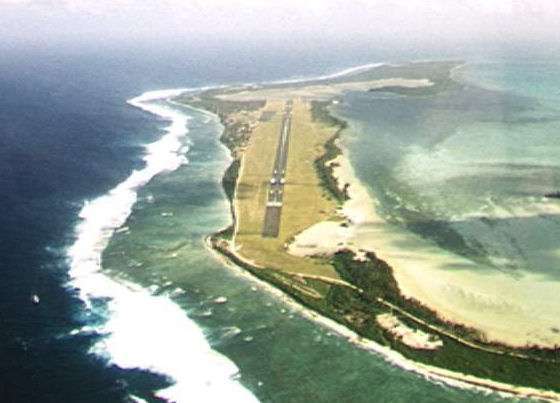 West Island. Credit Wikipedia
West Island. Credit Wikipedia
The Islands that make up the Cocos (Keeling) Island Group are part of a small atoll and are a very small speck in the Indian Ocean. Arrival at Cocos International Airport’s very large runway (2441m x 45m) is quite spectacular and landing can be very exciting, especially if there is a cross-wind. The Airport is on West Island, with the runway almost filling a long skinny section of the island. The Indian Ocean is only a few hundred metres away on either side of the runway. The runway also doubles as part of the Cocos Golf Course, but only with permission from the tower and only when no flights are expected!
The AFP officers’ main job was to interview various people on the islands and try to ascertain what had happen to Lorenz, as well as to supervise Tim Daly swimming the 2km or more from the middle of the lagoon to the shoreline. This he did achieve much to the amazement of many. My main job on the other hand was to thoroughly search Foxy Lady II from stem to stern.
Search Day 1. On Wednesday morning the skipper of the Pilot boat took me out to Foxy Lady II for my first day of searching, picking me up at the end of the day. Repeating the process over as many of the following days as was necessary. I had a week to search the yacht and decided to divide the yacht up into four main parts – 1. forward bunk area, 2. saloon area, 3. navigation & gally area and 4. toilet, shower & cockpit – devoting a day to each part. The first day I searched the rope and anchor locker, forward bunks including the storage area under, forward cabin cupboards and of course any personal possessions in any of those places. Nothing of interest found.
Search Day 2, I searched the Saloon area, including the table, lounge/bunks, water tanks under the bunks, all shelving, books and CD’s, Saloon bilges. Remember, I had all day so I was being meticulous, opening every CD case, every book and dismantling anything that I could (just as well I had previously helped my dad build several cruising type yachts!). Again, Nothing Found.
Search Day 3, started in the gallery area, removing everything from each cupboard, checking for any false fixtures in and around the cupboards, then checking every item as I restocked the cupboards. Still Nothing Found. Next was the Chart table area, all the cupboards, draws, shelves including all the contents. Looking closer I realised I could remove the entire chart table to inspect the area under it. Removing the chart table revealed one of the aluminium fuel tanks and not much else.
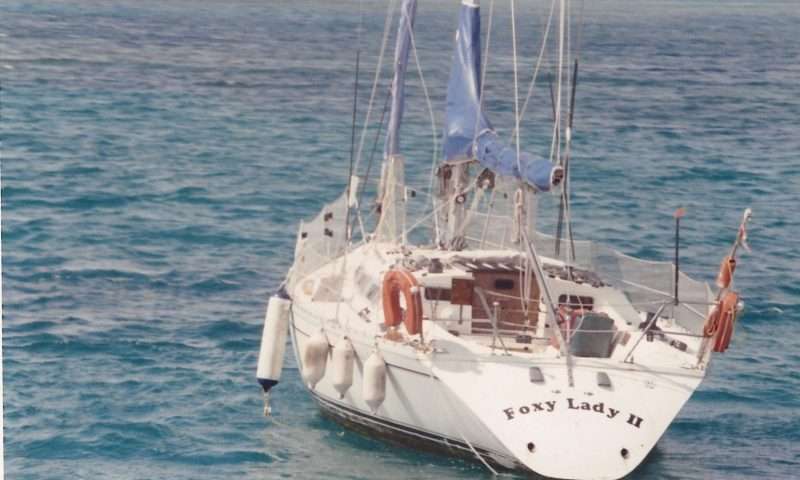
Satisfied, I picked up the chart table to reinstall it, that’s when I noticed one lonely strand of fibreglass sitting on top of the fuel tank. Not much unusual about that, it was after all a fibreglass yacht. BUT it did remind me of the information from Singapore Customs ‘…fibreglassed into a hiding spot…’. Placing the chart table back down again, I decided to have another, even closer look. That’s when I noticed additional fibreglass matt had been added, to bridge the gap from the top of the fuel tank across to the inside of the hull, creating a small, enclosed space underneath. It was slightly odd, so I decided to investigate further. I realised that unlike the rest of the yacht, which by then I was quite familiar with, this looked out of place and definitely didn’t match the precise workmanship shown elsewhere.
On closer inspection I could just make out, when shining a torchlight onto the semi- transparent fibreglass, a dark shadowy line behind it. Now galvanised into action I started prodding at the fibreglass near the shadow with a screwdriver. After a while I had a small hole through the fibreglass and into the space behind. The shadow, I could now see, was a piece of string, which I managed to hook out with the screwdriver. Pulling on the string, I extracted 200mm or so when there was a ‘clunk’, ‘clunk’ against the underside of the fibreglass. What? Enlarging the hole until it was somewhat bigger, I pulled through a hard object about 45mm in diameter and roughly 180mm long. What? Noticing that the string continued back down the hole, I kept pulling until I had 14 sausage shaped objects all connected by the piece of string, just like a string of sausages. ‘Oh shit, Jackpot’, I thought, nobody would go to all this effort if it wasn’t for real!
When the items were later dissected what was revealed was a sausage shape of Hash wrapped in alfoil, then plastic, with the whole lot immersed into fibreglass resin which had formed the hard outer surface.
The only communications that I had at my disposal was Marine VHF radio CH16, which is monitored by most vessels at sea, so the complete opposite of ‘private’. The AFP officers and I had devised some sort of verbal code for the extremely unlikely situation I found myself in. Nearly an hour later the AFP officers got a lift out to the yacht on the pilot boat and were elated with my discovery but completely out of their depth as they did not normally deal with drugs. Lots of questions ensued. “What do we do with the drugs now?”, “How do we get them back to Perth?”, “Does Tim Daly know anything about this?”, “What’s our next move?”. Then lots of photographs were taken of the drugs, the hiding spot, the chart table, the navigation area, etc, etc.
Later in the day we caught up with the Island Administrator and placed the drugs in his safe. The AFP officers contacted their head office to discuss what should happen next. The decision was made that they would take the drugs back to Perth and another AFP officer from Perth who WAS in the drug side of things would fly out on the Tuesday that the other two flew back to Perth. Then I was asked if I would be prepared to stay another week to assist the new AFP officer. “What, stay another week in paradise? You bet, bloody fantastic.”
There was a problem, however. Nobody had ever taken ‘illegal drugs’, ‘legally’ into Perth Airport before. How was this going to be achieved without being arrested? I was not involved in exactly how this was accomplished but fortunately something was rapidly devised so that the drugs could be taken into Perth Airport legally.
The next few days I continued to search the rest of the yacht, toilet area, aft cabin, engine compartment, aft stowage area and the deck area. Nothing more of interest located. By this time my continuous presence on the yacht each day had aroused suspicion with the locals, who were all starting to wonder who I really was. On the Monday of the following week, I agreed to do an interview on the local radio, where I revealed all – well, maybe not ‘all’, but certainly most of what had happened during the previous week.
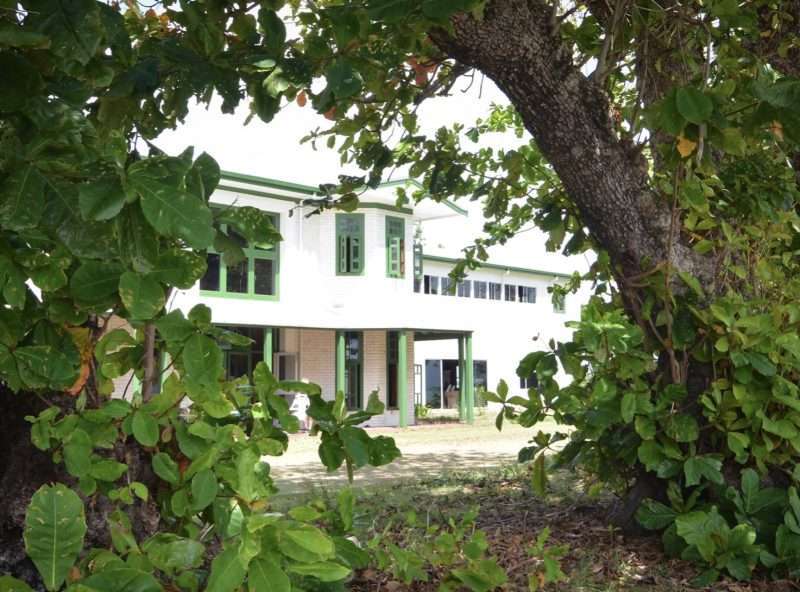
On the Tuesday the two AFP officers and Tim Daly left on the weekly flight, back to Perth. Arriving on the same flight was my new AFP partner for the next week. We spent the next few days investigating the drugs, reinterviewing persons, all a bit of a waste of time I thought; but who cared, I was enjoying myself. At one stage we caught the ferry over to Home Island where we met with John Clunies-Ross. His great-great-grandfather, (also John Clunies-Ross) who moved to the then uninhabited islands in 1897, planted hundreds of coconut palms, introduced Malay workers and built a business selling copra, the dried insides of coconuts. He also built the very impressive Oceania House of which we were given a guided tour.
On the weekend we finally had a day off and the skipper of the Pilot boat took us over to Direction Island, a great place and well worth the visit.
Finally, it was time to leave what had been a very successful mission, amazing adventure, with very friendly people, an idyllic lifestyle and great weather. What more could you ask for? We flew back via Christmas Island, where we were given a quick tour of the island by the local AFP officer while the plane was being refuelled. We arrived back in Perth in the early evening and ready for some well-earned days off.
You would be forgiven for thinking the story ends here – but no!
A special meeting was to be held on the Thursday after my return to Perth and I was expected to attend even though it was still one of my days off. A new group was to be established from that day called the ‘Remote Area Group’ of which the Marine Unit was to be part, hence my involvement. My wife decided to come with me as it was only to be for a few hours and she wanted to catch up with some of her friends in Personnel.
Just before the meeting started, the overall manager of the area – let’s call him my boss – indicated that he wanted to see me after the meeting in my immediate manager’s office. Still feeling a bit of a hero after my successful mission, finding the well concealed drugs on Foxy Lady II, I thought I was going to be congratulated. How wrong was I.
I started to sense something not quite right when I entered my manager’s office, and the boss was sitting at the desk with my manager standing and looking a bit sheepish behind him. The boss quite gruffly said, “Shut the door”.
I should point out here that all Marine Units have a reputation for stretching the rules and doing things their own way. The Fremantle Marine Unit, although not as ‘bad’ as some, still came from the same mold.
Then it was on, The boss laid into me (verbally), along the lines “…you bloody Marine Unit think you can do what you like…racking up overtime…expecting days off in lieu… even after an all-expenses tour of the Cocos Islands…I’ve had enough of it and will not tolerate it anymore…”, for emphasis he sharply prodded the desk with his finger after each point. Or something like that. I remember it went on for several minutes. So much, so fast, unable to get a word in, I was having trouble processing it all, especially as I had anticipated the exact opposite.
I have no idea why but at the end of the tirade, feeling all was lost, I stood up, not saying a word, took my badge and ID wallet out of my pocket and threw it on the desk in front of the boss. Then turned and stormed out slamming the door behind me. Hazel was not too far away in the corridor, unaware of the goings on but could read on my face that something was seriously wrong. She said, “Are you OK?”. Not answering I just said, “Come on, we’re out of here”. Once I got in the car all the emotion got the better of me and I burst into tears. My wife started to drive home and decided to call into see a colleague who had been my crew member on the ACV Edwin Abbott, in Applecross, which was conveniently on our way home. I explained the story to him while he made a cup of tea for us – he being as dumbfounded as I.
About half an hour later my colleague’s phone rings. He answers it and with a puzzled look on his face, says “It’s for you.” Picking up the phone, I hear the voice of the Head of the
Customs Department in WA on the other end. He had rung as he was trying to track me down. His first words were, “You haven’t resigned, I’ve promised the AFP that you can assist them with further study of the Foxy Lady II’s charts to ascertain the exact route travelled.” How quickly things change, from employed, to unemployed, to nothing has changed in the space of about two hours.
Later that week I did go into AFP offices in Perth and study the charts. I also had my fingerprints taken as, obviously, I had handled the drugs. A day or so later there was quite a baffling revelation from the AFP forensic division, ‘no fingerprints’ on the packages, not even mine! This had not been seen before and it was surmised that the fibreglass resin was not properly cured and had somehow ‘sweated’ the fingerprints off the surface.
Guess what? You’re right, we are still not at the end of this story.
Foxy Lady II had been seized by Customs because of its use in the importation of drugs into Australia. The problem was it was still in the lagoon at Cocos. Customs contracted Jon Sanders, he of the many circumnavigations of the world fame, to sail the yacht from Cocos to Fremantle. This he successfully accomplished without any further excitement. ACV Edwin Abbott met Jon and the Foxy Lady II on arrival in Fremantle and escorted them to the Fishing Boat Harbour, securing the yacht adjacent to the Customs birth. Foxy Lady II was later sold at government auction. This IS the END of the story.
Moral of this story – ‘Don’t get too cocky…’.
* By Bernie Webb
PLEASE HELP US TO GROW FREMANTLE SHIPPING NEWS
FSN is a reader-supported, volunteer-assisted online magazine all about Fremantle. Thanks for helping to keep FSN keeping on!
** Don’t forget to SUBSCRIBE to receive your free copy of The Weekly Edition of the Shipping News each Friday!
